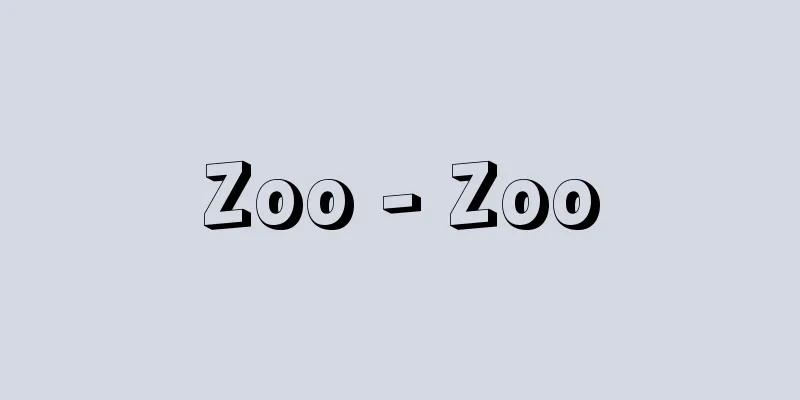Zoo - Zoo

|
A facility that collects, raises, and breeds live animals and makes them available for public viewing for educational and recreational purposes. Large-scale facilities are also called zoological parks. [Atsushi Komori] historyThere are many examples of royalty and nobility collecting and raising rare animals for the enjoyment of viewing them, including in ancient Egypt, China, Europe, and even the Aztec Empire in Mexico. However, the beginning of the modern zoo is said to be the Schönbrunn Palace Zoo, which was opened to the public in 1779 by Holy Roman Emperor Joseph II in Vienna, Austria. This was an animal collection that Francis I had spent seven years building for his wife Maria Theresa. In 1773, an animal breeding and exhibition facility called the Menagerie was opened in a corner of the Jardin des Plantes, a botanical garden attached to the National Museum of Natural History in Paris, France, and some say that this was the beginning of the modern zoo. In 1828, the Zoological Society of London opened a zoo in Regent's Park in England. In the United States, a small zoo was opened in New York's Central Park in 1865, but the first full-scale zoo is said to have been the Philadelphia Zoo, which opened in 1874. Other things that were related to the emergence of zoos were spectacles, and in particular bear pits, or "bear enclosures," which began to appear all over Europe from around the 15th century, could be considered the precursors of zoos. Also, when aristocrats began to have animal collections, animal merchants who supplied these collections began to make their own animals available for public exhibition for a fee, and this also saw the emergence of zoos. The most famous zoo of this type is Carl Hagenbeck Zoo, which opened in Hamburg, Germany in 1901, and it had a major impact on the development of zoos in terms of techniques such as animal taming and breeding and exhibition. In Japan during the Edo period, there were teahouses called kachojaya in places like Ryogoku and Ueno Hirokoji, where deer and peacocks were kept and tea was served to guests while they were on display. Some say that these were the origin of zoos, but it is believed that these kachojaya can still be found today in rooftop gardens with small animals at department stores and other establishments. Originating from the collection of exhibits for the World's Fair held in Vienna in 1871 (Meiji 4), a museum was opened in 1873 inside the Yamashita Gate near Hibiya (now the site south of the Imperial Hotel), where live animals were kept and exhibited. This was moved along with the museum to Ueno Park and opened in 1882, marking the establishment of Ueno Zoo, which can be said to be the first zoo in Japan. [Atsushi Komori] current situationZoos in Europe and Japan were devastated during the Second World War, but after the war, they were rapidly rebuilt and developed in response to the public's desire for peace. However, after the war, African and Southeast Asian countries that had once been European colonies gained independence and rapidly developed, leading to a major change in the way animals were collected for zoos. International cooperation also became a major issue, and in 1945 the International Federation of Zoo Directors was established, while in Japan the Japan Association of Zoos and Aquariums, which had been established before the war, was strengthened and became more active. In addition, consideration of nature conservation became important for zoos, and zoos began to rely heavily on their technology to breed rare animals. In response to these circumstances, zoos have started to develop what could be called specialized zoos that focus on the research and breeding of specific animals. In Japan, the Japan Monkey Centre, which opened in 1956, is a good example. Facilities established for the purpose of protecting and breeding rare animals have also started to open to the public. Representative examples of this are Slimbridge Waterfowl Park, which opened in the UK in 1946, and Jersey Zoo, which opened in 1959. Meanwhile, the size of zoos and the techniques used to display animals have also undergone great development. The Lion Bus at Tama Zoo (1964), which was based on the idea of allowing visitors to view free-roaming animals from inside a car rather than viewing animals in cages, later developed into a safari-style zoo in the UK, and this type of safari park has rapidly increased since then. As of 2002, the Japan Association of Zoos and Aquariums had 97 zoos and 71 aquariums as members. The International Zoo Yearbook , Vol. 36 (1998), lists the names of over 760 zoos (including aquariums) in 93 countries around the world. [Atsushi Komori] significanceTraditionally, the four functions that zoos fulfill in society have been: (1) education, (2) recreation, (3) research, and (4) nature conservation. In the second half of the 20th century, the role of (5) serving as an introduction to understanding nature was added. (1) Education The fact that zoos are educational sites can be seen from records of Greek zoos being used for educational purposes as early as the 4th century BC. In Japan, zoos are also subject to the Museum Law as a type of museum. Education at zoos is characterized by the fact that the teaching materials are there and live there, and rather than being a living museum, they are unique in that they can directly show the lives of the animals themselves. In order to strengthen this characteristic, methods such as explanations using labels and direct explanations by instructors are used, and many zoos overseas have established education departments as special organizations. However, the fact that these educational functions are performed independently by zoos and are not directly linked to the school education system will be a major issue in the future. In a similar sense, the fact that there is not necessarily sufficient cooperation with museums and botanical gardens that share the same purpose remains a problem. For zoos to function as true educational sites, it will be necessary to make use of their characteristics and work in close cooperation with other institutions. (2) Recreation This function is also an important pillar of the social function of zoos. It is said that the more human life becomes mechanized and people become more isolated from nature, the greater people's desire for nature, and zoos and botanical gardens exist to provide nature close to citizens. This type of citizen demand is expected to increase in the future, and in order to meet this demand, it will be necessary not only to exhibit animals, but also to have so-called ecological exhibits in which animals live in a natural environment. In this respect, the global trend of moving from urban zoos to suburban zoos is a manifestation of this. (3) Research This is another important function of zoos, and an indispensable part in academics, too. This is because zoos make it possible to study wild animals up close and in a planned manner, which is difficult due to the limited opportunities available. The Wellcome Institute of Comparative Physiology and the Nuffield Institute of Comparative Medicine, both attached to London Zoo, are examples of this, and the university research institute at Amsterdam Zoo is likely to have the same purpose. The results of these researches are not only useful for human medicine, but also make a great contribution to wildlife conservation efforts. (4) Nature conservation Nature conservation is the most modern issue for human beings. On the other hand, the unbridled development of human beings is seriously affecting the natural state, including animals and plants. In fact, it is said that 109 bird species and 88 mammal species have become extinct in the 400 years since 1600. The causes of this are the destruction of habitats due to human development and hunting, but the main reason is the lack of scientific knowledge about animals. In this context, the role of zoos is to utilize the knowledge and technology about animals that have been accumulated in the past in conservation activities and to function as a final resting place for animals in danger of extinction. It is also important to actively increase the number of endangered animals and revive them in the wild. In fact, there are many examples where zoo technology has been useful, such as the Arabian oryx, Hawaiian goose, and Siberian elephant, and efforts are being made in Japan for the Japanese crested ibis, rock ptarmigan, and Japanese serow. Regarding such efforts, the International Union for Conservation of Nature (IUCN) states in its New World Conservation Strategy (1991) that "in order to maintain species and genetic resources, it is necessary to combine in situ and ex situ conservation, and zoos have an important role to play in maintaining ex situ populations," and the 1992 Convention on Biological Diversity calls for "strengthening cooperation between in situ and ex situ conservation facilities in relation to the reintroduction of species into the wild and the recovery and restoration of habitats," clearly indicating the role of zoos in this field. In response to this, Japan's New National Biodiversity Strategy (2002) also calls for "the conservation of species in captivity," and describes the role of zoos in maintaining species ex situ. (5) An introduction to understanding nature In this respect, the role of zoos becomes more important the more mechanical human life becomes. Humans are also part of nature and cannot survive apart from nature. In the everyday lives of citizens, which tend to be isolated from the great outdoors, zoos and botanical gardens, as familiar natural sites, function by their existence to bring nature back into people's hearts. By visiting a zoo or botanical garden, people can learn about the existence and activities of organisms other than humans and get an opportunity to get a glimpse of the workings of nature. Furthermore, in order to meet this demand, zoos will need to make efforts to incorporate as much nature into their surroundings. [Shiro Nakagawa] OutlookIt is expected that zoos will play an increasingly important role in human life in the future. However, in order to meet this demand, it will be necessary to urgently establish an education system, introduce audiovisual technology, and switch to ecological exhibits. Furthermore, when collecting animals, a zoo stock system will be necessary, whereby zoos will secure zoo animals through international cooperation between each other. As for animal protection, it will be necessary not only to fulfill the function of preserving species, but also to fully utilize technology for protecting animals in the wild. Furthermore, in terms of exhibits, it is expected that there will be a shift from showing the animals themselves to showing the lives of the animals. [Shiro Nakagawa] "150 Years of London Zoo, by G. Vevers, translated by Haneda Setsuko (1972, Tsukiji Shokan)" ▽ "An Introduction to Zoology, by Nakagawa Shiro (1975, Tamagawa University Press)" ▽ "The History of Zoos: Japan and the History of Zoos: World (1975, 1977, Nishida Shoten)" by Sasaki Tokio ▽ "Cultural History of Animals 3: The Birth of Zoos, by H. Dembeck, translated by Konishi Masayasu and Watanabe Kiyoshi (1980, Tsukiji Shokan)" ▽ "Zoos and Wildlife Conservation, by Miles Barton, translated and supervised by Obara Hideo (1990, Yugakusha)" ▽ "World Zoo Organization et al., translated by the Japan Association of Zoos and Aquariums, World Zoo Conservation Strategy: The Role of Zoos and Aquariums in Conserving the Global Environment (1996, Japan Association of Zoos and Aquariums)" ▽ "Zoos as Media, by Watanabe Morio et al. (2000, Seikyusha)" ▽ "My Method of Studying Zoos" by Aoyama Kenichi (2002, Bungeishunju) ▽ "Because I Love Animals" by Masui Mitsuko (2003, Doubutsusha) ▽ "Zoo Design" by Sugaya Hiroshi (2003, INAX Publishing) ▽ "Zoos Are Fun Now" by Citizens' Zoo Network (2004, Iwanami Booklet) ▽ "The Asahiyama Zoo Revolution - The Revival Project that Realized a Dream" by Kosuge Masao (2006, Kadokawa Shoten) ▽ "What Zoos Can Do - The Future of the Ark of Species" by Kawabata Hiroto (Bunshun Bunko) [References] | |Ueno | | | | | | | | | | | | | | | | | | | | | | | | | | | | | | [Supplementary information] | |Japan's first modern zoo opened in 1882 (Meiji 15). Over 350 species of animals are kept in its 14-hectare grounds. It is popular as a friendly zoo in the city center, and is always crowded with visitors. Taito Ward, Tokyo ©Yutaka Sakano "> Ueno Zoo Japan's first modern zoo opened in 1882 (Meiji 15). "Tokyo Landscape" (1911 (Meiji 44)) National Diet Library Ueno Zoo in the Meiji Period Source: Shogakukan Encyclopedia Nipponica About Encyclopedia Nipponica Information | Legend |
|
生きた動物を収集・飼育し、繁殖させ、これを教育、レクリエーションなどのために一般の観覧に供する施設。大規模なものは動物公園ともいう。 [小森 厚] 歴史王侯貴族が珍しい動物を集めて飼育し、これを見て楽しんだ例は、古くからエジプト、中国、ヨーロッパ、さらにはメキシコにあったアステカ帝国などにもその例が知られているが、近代動物園の始まりは、1779年にオーストリアのウィーンで、神聖ローマ帝国皇帝ヨーゼフ2世によって一般に公開されたシェーンブルン宮殿の動物園であるとされる。これは、先代のフランツ1世がその皇后マリア・テレジアのために、7年の歳月をかけてつくった動物のコレクションであった。1773年には、フランスでもパリで国立自然史博物館付属植物園ジャルダン・デ・プラントの一角にメナジュリーとよばれる動物飼育展示施設が公開されたが、これをもって近代動物園の始まりとする説もある。さらに1828年になると、イギリスでもロンドンのリージェント・パーク内に、ロンドン動物学協会によって動物園が開かれている。アメリカにおいては、1865年にニューヨークのセントラル・パーク内に小動物園が開かれたが、本格的な動物園として最初のものは、1874年に開かれたフィラデルフィア動物園であるとされている。 このほか動物園の発生とかかわり合いのあるものには見せ物もあり、とくに15世紀ごろからヨーロッパ各地でみられるようになったベア・ピット、すなわち「クマの穴飼い」は、動物園の前身ともいえるものであった。また、貴族の動物コレクションが始まると、これらに動物を供給する動物商人が、手持ちの動物を有料で一般の展覧に供するようになり、ここにも動物園の発生がみられた。この種の動物園としては、1901年ドイツのハンブルクに開かれたカール・ハーゲンベック動物園がもっとも有名であり、ここは動物の馴致(じゅんち)、飼育展示などの技術面でも、動物園の発展に大きな影響をもたらしている。 日本では、江戸時代に両国とか上野広小路などで、シカやクジャクなどを飼って、客に見せながら湯茶を供する花鳥茶屋(かちょうぢゃや)などというものがあった。これが動物園の原型とする説もあるが、これら花鳥茶屋は、現在もデパートなどで小動物を置いた屋上庭園などにその姿をとどめているとみられる。1871年(明治4)ウィーンで開かれた万国博覧会への出品物収集に端を発して、1873年に日比谷(ひびや)に近い山下門内(現在、帝国ホテルの南側の場所)に博物館が開かれたが、その中には生きた動物が飼育展示されていた。これが博物館とともに上野公園に移され、1882年に開園したのが上野動物園の成立で、日本の動物園の最初ということができる。 [小森 厚] 現状第二次世界大戦によってヨーロッパや日本の動物園は壊滅状態となったが、戦後、平和を求める民衆の要望にこたえて急速に復興し発展を遂げてきた。しかし戦後においては、かつてはヨーロッパ諸国の植民地であったアフリカや東南アジアの諸国が独立し、開発が急速に進むなかで、動物園用の動物収集のあり方も大きく変化した。国際協力も重大課題となり、1945年には国際動物園園長連盟も発足し、日本においては、戦前に発足していた日本動物園水族館協会の組織が強化され、活動も活発となった。また、自然保護への配慮も動物園にとって重要なこととなり、希少動物の増殖について、動物園の技術に負うところが大きくなってきた。 このように状況にあわせて、動物園においては、特定の動物の研究・増殖に力を入れる専門動物園ともいえるものが生まれてきた。日本においては、1956年(昭和31)に開設された日本モンキーセンターがそのよい例である。また、希少動物の保護増殖を目的として設立された施設で、一般に公開されるものも生まれてきている。1946年にイギリスに開設されたスリムブリッジ水禽園(すいきんえん)や、1959年に開園されたジャージー動物園が、その代表的なものといえる。一方、動物園の規模や展示技術も大きな発展を重ねてきた。檻(おり)に入れた動物を見るのでなく、観客が車の中から放し飼いの動物を見るという発想による多摩動物公園のライオンバス(1964)は、その後イギリスでサファリ型の動物園へと発展し、その後この種のサファリパークが急速に増えた。 2002年(平成14)時点で社団法人日本動物園水族館協会に加盟している会員は、動物園97、水族館71である。『国際動物園年鑑』International Zoo Year book, Vol.36(1998)には世界で93か国、760以上の動物園(水族館を含む)の名があげられている。 [小森 厚] 意義動物園が社会に果たす機能としては、従来、(1)教育、(2)レクリエーション、(3)研究、(4)自然保護の四つがあげられていたが、20世紀後半に入って、(5)自然認識の導入口としての役割が付加された。 (1)教育 動物園が教育の場であることは、すでに紀元前4世紀ごろのギリシアの動物園が教育目的に利用された記録があることからもうかがうことができる。日本でも、博物館の一種として博物館法の適用を受けているのもその現れである。動物園における教育は、教材がそこにあり生活しているというところに特徴があり、生きた博物館というよりも、さらに、動物の生活そのものをじかに示すことができる点でユニークである。この特徴を強化する意味で、ラベルによる解説、指導員による直接解説などの方法がとられており、海外の動物園では、特別な組織として教育部を設けているものも多い。しかし、これらの教育的機能が動物園独自で行われており、学校教育システムと直接結び付いていないことは、今後の大きな課題となるであろう。また、同じような意味で、目的を同じくする博物館や植物園との協力関係がかならずしも十分でない点も問題を残している。動物園が真の教育の場として機能するには、その特徴を生かしつつ、他の機関との密接な連携による活動が必要となろう。 (2)レクリエーション この機能もまた動物園の社会的機能の重要な柱である。人間の生活が機械化し、自然との隔絶が進めば進むほど、人々の自然希求の度合いは高まるといわれ、市民の身近な自然として動物園や植物園が存在するからである。この種の市民需要は今後ますます増大するものと考えられ、これらの需要に対応するためには、単に動物を展示するだけではなく、動物が自然的背景の中に生活する、いわゆる生態展示が必要となろう。この点では、都市型動物園から郊外型動物園への移行が世界的傾向となっているのが、その現れである。 (3)研究 これもまた動物園の重要な機能であり、学術上も欠くことのできない部分である。どうしても機会が少なく、詳細な研究対象としてとらえがたい野生動物を、身近に、しかも計画的に研究することが動物園では可能であるからである。ロンドン動物園に併設されているウェルカム比較生理研究所、ナッフィールド比較医学研究所などはその現れであり、アムステルダム動物園に大学の研究所が設置されているのも同じ目的によるものであろう。これらの研究成果は、人間医学のうえに役だつばかりでなく、野生動物の保護事業のうえにも大きく貢献している。 (4)自然保護 人類にとって自然保護はもっとも現代的な課題である。人間のとどまるところのない発展は、その反面、動物・植物を含む自然の状態を著しく圧迫しているからである。事実、1600年以後400年の間に鳥類のうち109種が絶滅し、哺乳(ほにゅう)類88種が消滅したという。この原因は、人間の開発による生息環境の破壊や狩猟などであるが、その基本には、動物に対する科学的知識の欠如が最大の理由として存在する。このような背景のなかで、動物園が果たす役割は、過去に積み上げてきた動物についての知識技術を保護活動に生かすことであり、また、絶滅の危機にある動物たちの最後の安息所として機能することであろう。さらに積極的には、絶滅の危機にある動物を増やし、ふたたび野生によみがえらせることも重要である。事実、アラビアオリックス、ハワイガン、シフゾウなど、動物園技術が役だった例は多く、日本でもトキ、ライチョウ、カモシカなどについて努力がなされている。このような取組みについては、国際自然保護連合(IUCN)が、新世界環境保全戦略(1991)のなかで「種と遺伝子資源を維持するために、生息地内と生息地外での保全を併用する必要があり、動物園は生息地外個体群の維持に重要な役割をもつ」とし、また、1992年の生物多様性条約では「種の野生復帰や生息地の回復・復原に関し、生息地内と生息地外の保護施設間での協力関係の強化」を掲げ、この分野における動物園の役割について明示している。これを受けて、日本の新生物多様性国家戦略(2002)においても「飼育栽培下における種の保存」を掲げ、生息地外における種の維持について動物園の役割を述べている。 (5)自然認識の導入口 この面で動物園の果たす役割は、人間の生活が機械的になればなるほど重要性をもつ。ヒトもまた自然の一部であり、自然を離れては生存しえないからである。大自然と隔絶しがちな市民生活のなかで、身近な自然としての動物園や植物園は、その存在によって、自然をヒトの心のなかに呼び戻す機能をもつ。動物園や植物園を訪れることによって、人間以外の生物の存在と営みを知り、自然の仕組みをかいまみる機会を得るのである。そしてまた、この需要にこたえるためには、動物園はより多くの自然をその中に取り込む努力が必要となろう。 [中川志郎] 展望人間生活のなかで、動物園の存在は今後ますますその重要性を高めると思われる。しかし、その需要にこたえるためには、教育システムの確立、視聴覚技術の導入、生態展示への変換などが急務となり、また、動物の収集にあたっては、動物園どうしの国際的な協力による動物園動物の確保zoo stock systemが必要となろう。動物の保護については、種の保存的な機能を果たすことはもちろん、野生での保護のためにその技術を十分に発揮することが必要となる。また、展示にあたっては、動物そのものをみせることから、動物の生活をみせる方向に移行するものと思われる。 [中川志郎] 『G・ヴェヴァーズ著、羽田説子訳『ロンドン動物園150年』(1972・築地書館)』▽『中川志郎著『動物園学ことはじめ』(1975・玉川大学出版部)』▽『佐々木時雄著『動物園の歴史 日本編』『動物園の歴史 世界編』(1975、1977・西田書店)』▽『H・デンベック著、小西正泰・渡辺清訳『動物の文化史3 動物園の誕生』(1980・築地書館)』▽『マイルズ・バートン著、小原秀雄監訳『動物園と野生生物保護』(1990・佑学社)』▽『世界動物園機構ほか著、日本動物園水族館協会訳『世界動物園保全戦略 世界の動物園と水族館が地球環境保全に果たす役割』(1996・日本動物園水族館協会)』▽『渡辺守雄ほか著『動物園というメディア』(2000・青弓社)』▽『青山健一著『私の動物園勉強法』(2002・文芸社)』▽『増井光子著『動物が好きだから』(2003・どうぶつ社)』▽『菅谷博著『動物園のデザイン』(2003・INAX出版)』▽『市民ZOOネットワーク著『いま動物園がおもしろい』(2004・岩波ブックレット)』▽『小菅正夫著『「旭山動物園」革命――夢を実現した復活プロジェクト』(2006・角川書店)』▽『川端裕人著『動物園にできること――「種の方舟」のゆくえ』(文春文庫)』 [参照項目] | | | | | | | | | | | | | | | | | | | | | | | | | | | | | | | | [補完資料] | |1882年(明治15)に開園した日本初の近代動物園。広さ14haの敷地内に、350種を超える生物が飼育されている。都心にある身近な動物園として人気があり、数多くの来園者でにぎわう。東京都台東区©Yutaka Sakano"> 上野動物園 1882年(明治15)に開園した日本最初の近代動物園。『東京風景』(1911年〈明治44〉)国立国会図書館所蔵"> 明治時代の上野動物園 出典 小学館 日本大百科全書(ニッポニカ)日本大百科全書(ニッポニカ)について 情報 | 凡例 |
>>: Animals - Animals (English)
Recommend
Cutting ties - Enkiri
Enkiri refers to human relationships in general, s...
Virtue - Toku
An important concept in Chinese ethical and polit...
Kakebukusa - Kakebukusa
A fukusa is a wrapping cloth used to wrap gifts an...
Angel Skin
...Bokeh on a red background is called "red ...
Huancayo (English spelling)
The capital of Junin Department in central Peru. I...
Living Doll - Ikeru Ningyo
...Because this film is permeated with socialist ...
Shambhala
...A legend about Shambhala (Shambala), a Buddhis...
Oonimasu Mishiritsuhiko Shrine
…According to the Kojiki and Nihon Shoki, the anc...
Creatine phosphate (creatine phosphate)
Also known as phosphocreatine, it is one of the ph...
Modern man (English spelling) Sovremennik
A literary magazine from Imperial Russia. Also tr...
Self-propelled gun
A gun mounted on a vehicle so that it can move in...
Saonetsuhiko - Saonetsuhiko
He appears as a guide in the story of Emperor Jimm...
Abyssinia International African Friendship Association
...In 1929, the conference was planned to be held...
Salep
...In Greek mythology, Orchis, the son of Satyr, ...
Montelimar (English spelling)
Ancient name Acunum. A town in the Drôme departmen...









